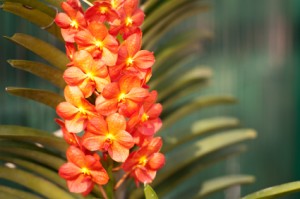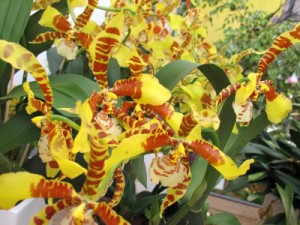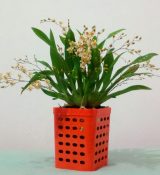What You Ought to Know About Keikis
Author: Celeste Booth14 Comments
Keiki is the Hawaiian word for baby or child. In the world of orchids, it means something very similar, a baby orchid plant. The keiki is an exact copy of the original plant that grows from a node on the stalk or cane of an orchid plant. They occur most typically among the Dendrobium, Epidendrum, and Phalaenopsis genera of orchids. Keikis form on other genra of orchids as well, but it is less common. Once a keiki forms on an orchid, it can be left on the mother plant and will usually grow into another flowering plant, while still attached. Or, the plant can be removed and propagated into an individual plant. Starting a new plant can be an easy way to add to your collection or share a loved orchid with a friend. It just takes a few easy steps.
How a Keiki is Formed

Orchid Flowers
There is no way to know for sure if or where your orchid plant will produce a keiki. It happens when there is a build up of growth hormones at the node. The nodes are the small bumps along the spikes. In order to encourage a keiki to grow you can apply keiki paste or liquid to the nodes. These products typically have synthetic cytokinins that encourage cell division and growth of new tissue, and some contain synthetic auxins to stimulate growth. The downside to these products is that they are expensive and there is no guarantee that they will work every time. If you have a specific specimen that you definitely want to replicate, it may be worth the investment. Otherwise, you may be better off just waiting for the keikis to form naturally. Many varieties of Phalaenopsis are particularly skilled at producing keikis.
Removing a Keiki
Once a keiki has begun to form on your plant, you will now play the waiting game. Patience is essential. If you remove your keiki too early, it will not have the healthy start it needs to survive the transplant and establish itself as an individual plant. Before you remove the keiki, it should have several roots, that are at least two inches long. It should also have a few small leaves. Be sure both leaves and roots are present before you cut the spike. Once your keiki is developed to the appropriate size you can cut it away from the cane. Be sure to sterilize your cutting tool to avoid transferring any disease to the mother plant or the keiki. Once your tools are sterilized, cut away the cane two inches above the keiki. Then, cut the keiki away from the cane two inches below the keiki, making sure to steer clear of the tender, new roots. As a precaution, you may want to apply fungicide to the cut areas on both the mother plant and the keiki. Cinnamon works as an effective natural fungicide.
Potting Your Keiki
Now you are ready to pot your keiki. You will want to use a pot that will be large enough to allow for one year of growth. A four inch pot should be as big as you need. Sphagnum moss is one option for a potting medium for orchid keikis. Other options include a special commercial potting mix specifically for orchids, bark, cork, and peat moss. If you are using moss, be sure the moss is damp ahead of time. Then pack some moss into the bottom of the pot. Next, measure to make sure that the bottom of the first few leaves of the keiki will align with the top of the pot. Once you have the right amount of moss in the bottom, wrap a ball of of moss around the keiki just a little larger than the size of the pot. Then pack the moss into the pot tightly so that the keiki is well supported and will not tip. It is also important to remember to label you newly potted keiki. Be sure to include the genus and species, and the date it was planted. This will help you keep track of all of your keikis and their progress. If you choose to give it away, this will also help the recipients know how to properly care for their new orchid.
Different Types of Containers
There are several advantages and disadvantages to different kinds of containers. Clay pots allow the growing media to dry quickly, preventing root rot. They also provide stability to the more top heavy orchids. Clear, plastic pots allow you to view the contents of the pot. This way you can monitor the moisture level in the pot, as well as the health of the roots. It is also believed that the roots can perform photosynthesis through the clear pots, improving the overall health of the orchid. No matter what pot or potting materials you choose, be sure that it allows for good drainage, and keep a close eye on moisture levels. If the pot you originally chose doesn’t seem to be working out, simply repot your new orchid in an alternative.
Fertilizing
Now that your keiki has a new home, you should wait to fertilize it until it is well established in its pot. If you add fertilizer too soon, it could shock the keiki after an already traumatic move. Once the leaves show a little growth, you will know the keiki is happy and established in its new home. Then you can add fertilizer specially formulated for orchids. Always be sure to read labels and follow instructions on fertilizer carefully.
Light

Tiger Orchid
You must also be careful not to expose your keiki to too much direct light. To much direct sunlight can prevent you from having a successful transplant. Once the keiki is in its pot, gradually expose it to bright light, but not direct sunlight. As the keiki begins to show growth increase the amount of light a few days at a time until it is growing happily and a receiving the same amount of light as its mother plant.
Growth
In its own pot, your keiki will probably take about two years to grow to a mature flowering size. Attached to the mother plant this will happen faster. If you leave the keiki attached to the mother plant, be sure to feed the mother plant regularly with fertilizer, as it is providing nutrients for both itself and the keiki.
Tips to Remember
With patience and care you can have a copy of your favorite Phalaenopsis, Dendrobium, or Epidendrum. Just keep a few, very important things in mind:
- Allow the Keiki to grow at least two, 2 or 3 three inch roots and a few leaves before removing from the mother plant. It must have both!
- Sterilize your cutting tools and apply fungicide to keep mother and keiki free from disease.
- Pot the Keiki in a small pot that will allow for one year of growth.
- Use a pot and potting media that will allow appropriate drainage.
- Fertilize only slowly at first, until the keiki shows signs of being well established.
- Alway monitor moisture carefully. Don’t let the orchid get too soggy or too dry.
Sources
American Orchid Society, http://www.aos.org/Default.aspx?id=97
Orchid Board, www.orchidboard.com
Keiki, Wikipedia, http://en.wikipedia.org/wiki/Keiki
14 Responses to “What You Ought to Know About Keikis”
Leave a Reply


Ask an Expert
Questions about orchids?
Our experts love a challenge!
Photo of the Week
Submit your photo to be featured on the blog!
More Photo of the Week Winners
Submit Photo








I have a Phalaenopsis Orchid and a few months after the flowers fell off, it started to grow between the leaves, long green “appendages” with a brownish tip. Two of them are now about 5 inches long and more are starting between the other leaves. There are no roots or leaves on them, and I don’t know what to do with them. I don’t think they are baby orchids, as they are not growing roots and they start from right in between different leaves. The plant itself has 3 leaves on each side, and one more coming out from the center. The plant looks very healthy. Can you help? Carmen
Sounds like a basal keikis
I HAVE A HEALTHY KEIKI THAT DOES NOT HAVE ROOTS YET. ALL THE LEAVES HAVE TURNED YELLOW AND FALLEN OFF THE MOTHER PLANT. WILL THE KEIKI CONTINUE TO GROW, OR IS IT DOOMED?
Zanne, have you tried to wrap some sphag around the base of the keiki? Keeping that medium moist may help the keiki to produce roots.
I also have several light green appendages with a brown tip. you said they are a basil keiki. what does that mean? are they going to be flowers or not? what do I do with them? I have them tied to a dowel.
A basal keiki just means it is located near the base of the orchid. If you have a basal keiki, you will want to leave it alone as it’s sharing the same root system with the mother plant. Often times this happens when the mother plant is dying, and the new keiki will become your new healthy orchid plant.
Hello! I need an advice. I have 4 keikis that are fully grown,i left them atthached to the mother,but i want to repot them. The problem is that all of them have floral blossom that already have 15 cm each and soon to have flowers. What is your opinion? when and how can i repot them so the keikis wont die? thank you in advance!
Whether or not the keikis have roots is the important thing here. I have had a few keikis that bloomed before having enough root to be transplanted. be patient and wait until you have a few good roots on the keiki, before removing it from the parent plant.
My plant has a keiki with 4 leaves and roots that are 4 inches long. It has started to put forth a flower spike. Do i leave it as it is and wait for it to flower and then transplant it or can i do it right now?
Yes you can leave it on the other plant while it blooms (sometimes the keiki and the mother plant will bloom together). Afterward you can transplant it to a new pot.
Hi everybody! I have a Phalaenopsis and her keiki has 7 roots (7 in long) and 6 leaves. I would like keep them together but making the mother plant stronger, less stressed by the keiki’s growth. The problem is how to feed the keiki, considering the roots are growing considerably vertically. Would it be enough to add some substrate in some way, and keep both healthy? Please note that I don’t want to separate them. Any ideas?
Thank you!
I forgot to add, by the way, mother and keiki are both in full bloom now!
I have a keiki that I had to remove way before it was ready as the mother plant has completely died. It has two little roots poking out the bottom and two full leaves and is currently putting out another leaf. I would really love to keep this little one alive and any advice will be appreciated. Thank you anyone for their time
Sounds great! It’s always a good sign when the keiki has roots. Let us know if you have any specific questions or concerns. Have you repotted it into a small pot (4″ pot is fine for a keiki).